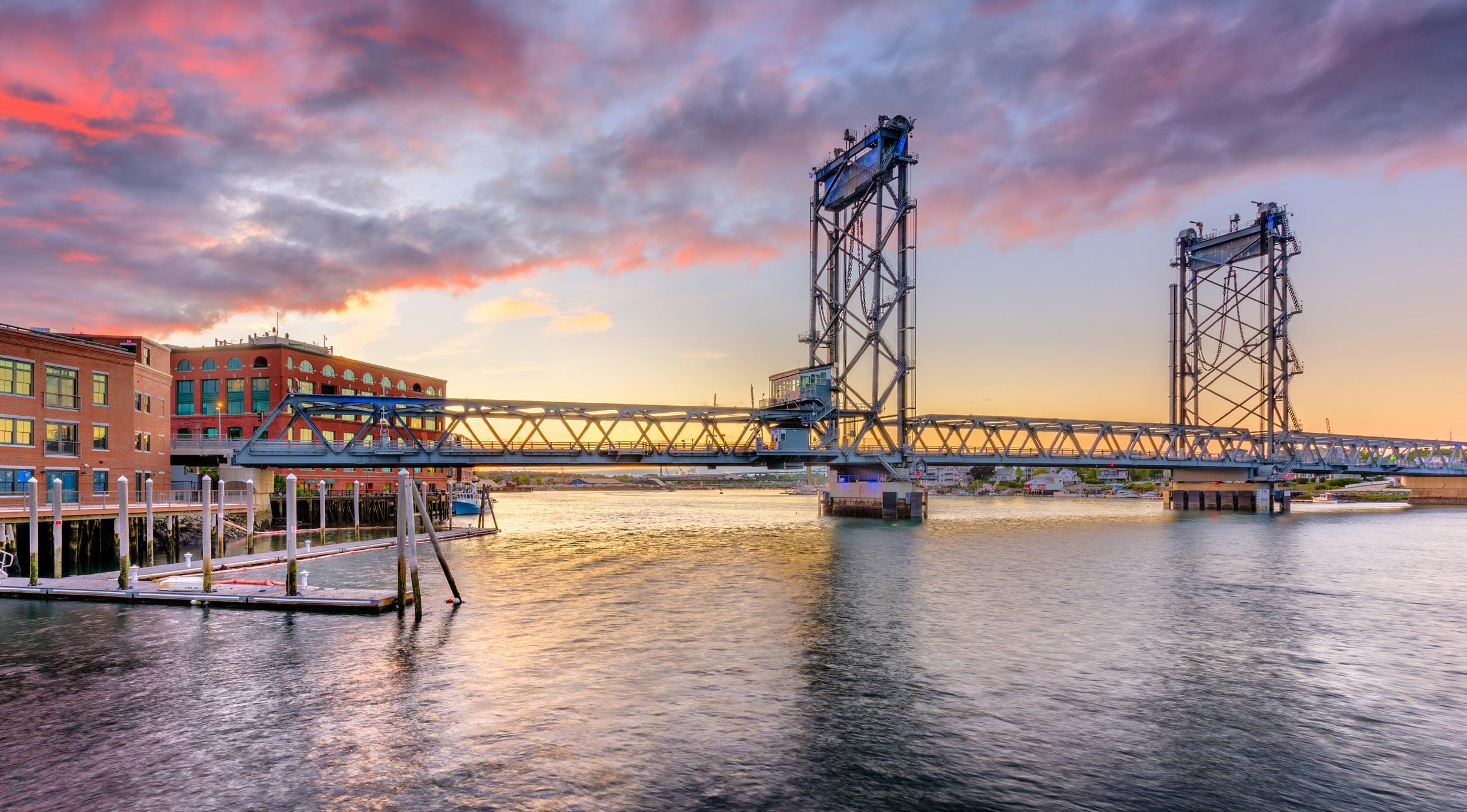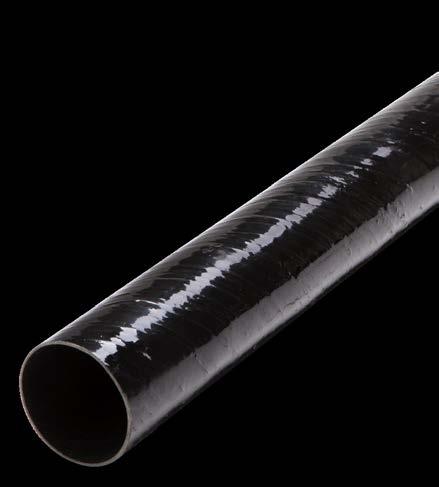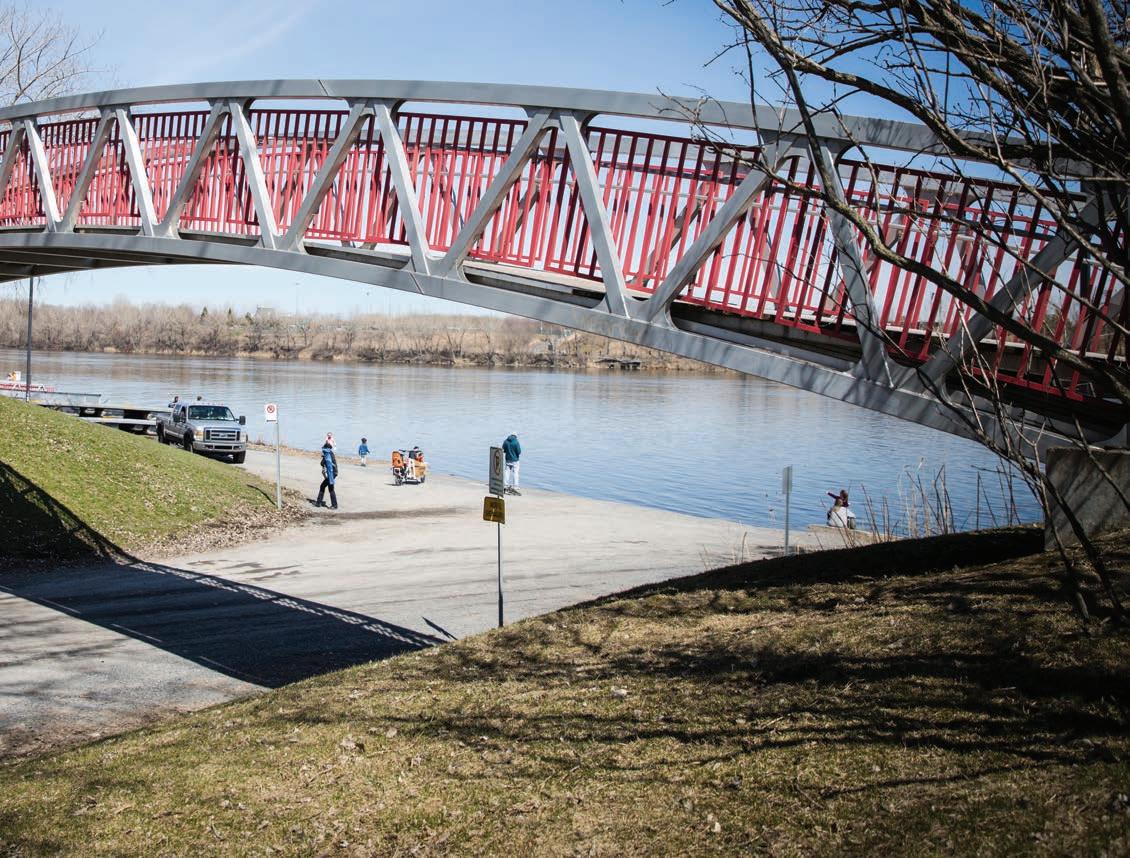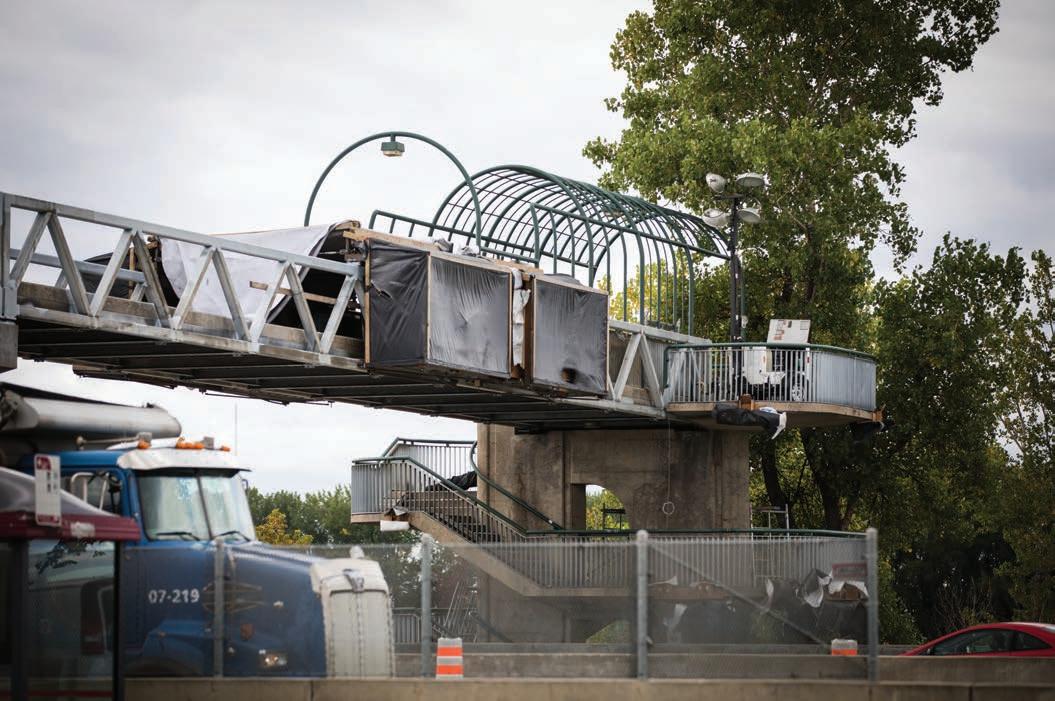Lightweight electrical conduit installation
Seismic bridge design The advantages of aluminum







Champion Fiberglass® helps make a complex installation seamless, safe and on-schedule
A bridge’s recent construction involved the installation of two under-bridge duct banks that would provide a protected pathway for buried electrical and data cables. When working at such great heights, installation requires efficiency to help minimize the high cost of necessary equipment.
Successful strategies for seismic bridge design Designing buildings and infrastructure to withstand major

earthquakes is challenging and has a significant cost, but can be justified as a preventative measure when, by way of example, the Insurance Bureau of Canada (IBC) estimates the cost of a magnitude-9 earthquake in British Columbia would be almost $75 billion.

Aluminum has only relatively recently become a common construction material choice. Today, it is successfully used for many applications where low weight is an advantage. It is the most easily and frequently recycled material and offers the highest scrap value. And it is a durable option for infrastructure.

The Frederick Douglass Memorial Bridge in Washington, D.C., is a new through arch bridge that carries South Capitol Street over the Anacostia River. The bridge is 1,472 ft long and serves to in crease pedestrian and vehicular safety, improve multimodal transportation options, increase community access and support economic development on both sides of the river.
The recent construction of the bridge involved the installation of two under-bridge duct banks that would provide a protected pathway for buried electrical and data cables. When working at such great heights, installation requires efficiency to help mini mize the high cost of necessary equipment. Lightweight products help to keep installers safe throughout the project.
The installation of the duct banks was challenging, with cus tomized requests and specific timelines. Accurate take-offs were critical, as was the ability to handle the specific logistics for the order size, lead times and customization, like pre-assembly.
Due to the complexity of the installation, the contractor need ed a reliable partner that could not only customize the product and delivery, but also stay on schedule.
Not only did this contractor need a lightweight electrical conduit to facilitate a safe installation, they also required a partner experi
enced in providing customized solutions. This project was loaded with special requests and specifics, such as pre-assembly of duct banks and detailed shipping with tight deadlines.
Champion Fiberglass® went above and beyond to co-ordinate the complex installation by customizing the pre-assembled duct banks with special packaging. Specifically, customization includ ed pre-drilled and pre-assembled ducts and hangers, expansion joints built into the duct packages and specialized duct crating and packaging. Finally, shipping was expedited to ensure on-time delivery.
Champion Fiberglass met specific project assembly and shipping requirements for the contractor and hit deadlines without a hitch. By using Champion Fiberglass’ lightweight conduit, which facili tated an easier installation, the risk to the installers was substan tially minimized.
The seamless installation led directly to savings without losing quality or sustainability. In addition to hitting installation time lines, the contractor and customer experienced peace of mind knowing the conduit materials are corrosion-, UV- and impact-re sistant and temperature-tolerant for longevity in the field.
The strength and durability of Champion Fiberglass’ conduit and customization solutions, afforded by 30-plus years of project expertise, helped this bridge project reach a successful conclusion.


U.S.


Designing buildings and infrastructure to withstand major earthquakes is chal lenging and has a significant cost, but can be justified as a preventative measure when, by way of example, the Insurance Bureau of Canada (IBC) has estimated the cost of a magnitude-9 earthquake in British Columbia would be almost $75 billion.
Universities across Canada have conducted research on earthquake engineering for those provinces with higher seismic risk, including British Columbia, On tario and Quebec. Professional and technical associ ations have also developed seismic design guidelines.
As a result of these efforts, seismic design has evolved significantly in the past decade, as reflected in the ongoing revisions of most structural design codes. Provisions of the Canadian Highway Bridge Design Code (CAN/CSA-S6-14) and National Building Code (NBC-2015) have been revised substantially to incor porate advances in seismic design and newly available earthquake data.
The revised codes incorporate new seismicity maps and design provisions. CAN/CSA-S6-14 adopted a performance-based design (PBD) approach, with cri teria based on meeting specific requirements for dif ferent bridge categories, based on their importance and given a specified seismic hazard. Unlike tradition al force-based design (FBD), which uses minimum earthquake force to ensure no collapse, the PBD ap proach sets out structural, functional and service performance criteria to limit damage and ensure ser viceability and emergency response.

Seismic forces are random and complex to assess. For this reason, structural design codes incorporate a probabilistic approach. Critical parameters, such as earthquake magnitude and seismic activity for specific return periods, location and geological and site soil conditions, define the maximum earthquake ground acceleration, which in turn informs the design spec trum. The seismic force on a particular bridge is de fined by its mass, structural system, dimensions and materials.
There are multiple ways to design a safe bridge under seismic actions, but it is not economical to at tempt to avoid all damage under a strong earthquake. Rather, the PBD approach allows for some damage while ensuring no collapse for a moderate to strong seismic event with low probability and prevents brittle failures. Sound seismic design principles incorporate ductility, energy dissipation and capacity concepts to achieve a fusion-like action or damping mechanisms, accepting reparable damages in specific parts of the structure or large displacements during an earthquake.
Two of the most effective tools for protecting bridges from earthquake damage by reducing seismic forces are (a) base isolation and (b) energy dissipation de vices. Both of these technologies are suitable for either new construction or retrofits.
The concept of base isolation is to introduce specially designed, flexible bearings that accommodate large seismic displacements and decouple the structure from ground motions, shifting the vibration periods of
the structure to reduce the earthquake acceleration— keeping in mind the bridge will experience larger displacements that, in some situations, are difficult to accommodate.
Base isolation is typically achieved by installing the bearings to provide a horizontal target flexibility, while adding energy dissipation devices to control the dis placements.. The use of base isolators is a cost-effective approach for small- and medium-span bridges in high seismic regions.
The energy dissipation concept introduces additional damping in the structural system, typically by install ing shock absorbers that allow slow movements in service conditions, but provide displacement control, dissipate energy and transmit forces under sudden movements, such as earthquake motions.
As mentioned above, shock absorbers are often combined with seismic isolators to both reduce seismic forces and control displacements.
Colombia is one of the seismic-prone countries with the highest earthquake hazards, with maximum peak ground accelerations comparable to the most danger ous locations in British Columbia and Quebec. For this reason, seismic isolation is frequently used for the country’s short- and medium-span bridges. The two following examples illustrate the effective use of base isolation and shock absorbers.
First, in the city of Cali, a new south expressway spans 44th Street with a 120-m long, 12.4-m wide bridge, monolithically connected to a 130-m long, 7-m wide ramp structure. The superstructure is a post-tensioned concrete slab.
Both technical and esthetic considerations drove the design of this urban bridge. The project included high-damping rubber bearings (base isolators) in all piers and abutments. With this approach, the vibration period increased from 0.33 to 1.90 seconds. By shifting this fundamental period, seismic demand was reduced by 65% in the longitudinal direction and 57% in the transversal direction, leading to significant cost savings in the foundations and substructure.

Secondly, in the town of Honda, the Magdalena River is crossed by a new 407-m long, 16.3-m wide cable-stayed bridge with two traffic lanes, including a main span of 247 m and two back spans of 80 m each. The stays are anchored in H-shaped towers, 60 m high above the deck level. The towers are founded on 12.2m diameter concrete caissons, up to 38 m deep. The abutments are massive counterweights to which six stays are anchored; through free pot confined elasto meric bearings, they take the uplift force from the backstays.

Due to the high seismicity and poor soil conditions of the location, the project team decided to use high-damping rubber bearings over the piers to in crease shock absorption in both directions, accepting minor repairs in case of earthquake. With this strategy, the fundamental vibration periods were increased to 5.5 seconds in the longitudinal direction and 3.1 seconds in the transversal direction, achieving a 40% reduction of seismic forces.
To limit the longitudinal direction’s displacements, the design incorporated four hydraulic dampers with a load capacity of 750 kN each and a 300-mm stroke capacity. The combined solution of shock absorbers and base isolation resulted in a considerable reduction of the foundations and, thus, considerable cost savings.
It is not economical to attempt to avoid all damage under a strong earthquake.

luminum became a common construc tion material choice relatively recently. Today, it is successfully used for many applica tions. Its low weight is an advantage for cars and planes, for example, to improve their fuel efficiency. It is the most easily and frequently re cycled material and offers the h ighest scrap value. And it is a durable option for buildings and structures.
Steel and concrete were the dominant materials for pedestrian and vehicular bridges for decades, while aluminum was given little consideration. Today’s architects, however, have recognized the ad vantages of aluminum with regard to total cost of ownership (TCO); while the initial costs of construc tion and installation are higher, the ongoing costs of repairs and main tenance are lower.
That said, early attempts to use aluminum in bridges were not al ways successful, as engineers did not yet fully understand the materi al and how to work with it. Only
now is that changing.
Aluminum has many characteris tics that make it attractive for a variety of applications, including pedestrian and vehicular bridges.
The first, as mentioned earlier, is its high strength-to-weight ratio, which improves efficiency for its transportation, assembly and in stallation. Further, by reducing the dead load of a bridge deck, the live load can be increased.
Aluminum is highly resilient. It can flex under loads and spring back from the shock of an impact. It is also great for cold weather. Unlike most other materials, it does not lose its ductility when the temperature drops. Instead, alum inum actually becomes stronger at lower temperatures.
For outdoor structures, durabil ity is its most crucial advantage.
Aluminum generates an invisible protective oxide coating, providing high resistance to atmospheric corrosion.
Thanks to its high malleability, aluminum can be transformed for
many applications. It offers high rigidity and energy absorption. Through extrusion, aluminum profiles can assume complex shapes, maximizing geometric properties or incorporating grooves, hollow areas or other linear features for a specific pur pose.
Aluminum can be easily assem bled with other materials and to day’s engineers can avoid common problems, like galvanic corrosion, seen in the past.
Unlike steel, aluminum does not require paint or other protective finishing, except to enhance its appearance. Indeed, aluminum structures do not need to be paint ed for their entire lifetime, up to 100 years. Also unlike steel, they can be sanded or pressure-washed to remove graffiti without damag ing their finish.
As mentioned, aluminum is easily recycled. Claims that steel has a smaller carbon footprint are
Aluminum is highly resilient.
true only for primary aluminum, which is produced from raw baux ite/alumina, but the majority of aluminum used in North Amer ica—including extrusions for bridges— contain recycled alum inum, representing a much smaller carbon footprint than steel. Alum inum has a much lower melting point and basically does not lose any of its inherent properties or quality during recycling.
Additionally, the cost of recycled aluminum is lower than that of primary aluminum.
The first aluminum bridge struc tures built from the 1930s and ’60s were made of Al-Cu alloys, which were strong but difficult to extrude into complex shapes. They were also subject to significant corrosion problems, leading to early failures.
Built 18 years ago, the Verdun marina bridge, made with mill-finish aluminum, has never required repairs or maintenance.


The introduction of Al-Si-Mg al loys, which depend on Mg2 Si precipitation hardening, greatly facilitated the extrusion of beams with complex hollow cross-sections that were more resistant to corrosion. Newer bridges around the world have been made with these alloys— and, in most cases, with a high amount of recycled content or certified sustainable low-carbon primary aluminum.
Design choices are often limited by stiffness and fatigue. Most bridg es today use standard Al-Si-Mg al loys with T6 temper because they offer the same modulus of elasticity and fatigue strength as special high-strength versions.
In one commercially available bridge design, weld-free aluminum decking enables a maximum al lowed vehicle weight of 15 tons for pedestrian, movable, temporary and military bridges, maritime structures and construction plat forms.
To illustrate the differences between steel and aluminum, consider two pedestrian bridges along the St. Lawrence River. The first, located in Verdun on the island of Montreal, is an aluminum bridge built 18 years ago. The second is a steel and con crete bridge installed in 1988 in Longueuil, on the south shore. A few kilometres apart, they face the same climate and were designed for the same live load.
The Verdun marina bridge is a 25-m long and 3-m wide arched pony truss bridge constructed in 2002 with Cumaru wood decking by Technom arine in accordance to CAN/ CSA-S6-00, the Canadian Highway Bridge Design Code. It was designed for a live load of 4.8 kPa.
Only the vertical pickets have a powdercoated finish. The rest is natural mill finish aluminum.
According to the Borough of Verdun, the bridge has never re
quired any repairs or maintenance in its 18 years. Indeed, it should not require any maintenance or major repairs over the next few decades.
Marigot hot-dip galvanized steel foot bridge
The Marigot pedestrian bridge on Marie-Victorin Boulevard in Lon gueuil is a galvanized steel structure with a reinforced concrete deck, 127 m long and 3.86 m wide, featuring several simple spans with steel pony trusses. It was built in 1988.
Reinforced concrete slabs com prise the deck, which rests on steel girders arranged in three simple spans. It is longer than the alum inum bridge, but similar in width, design, use and live load.
The Marigot bridge has required repairs and regular preventive main tenance. In 2014, by way of example, t he cost of prepping and metal spraying the steel surfaces and tak ing environmental protection measures was $302,000. Similar maintenance was needed again in 2019, by which point it cost more
than $322,000—and that same year, the bearings, deck support and guardrails were replaced at a cost of $190,000.

So, the bridge needed $814,000 in repairs and maintenance over a fiveyear period. Additionally, several hundred thousand dollars were in curred for organization, administra tion and traffic management on the site
Comparative analysis of mainten ance costs confirms the TCO of hot-dip galvanized steel in an urban setting exceeds that of aluminum after 33 years. And as mentioned, a well-designed and -constructed aluminum bridge has a lifespan of 100 years. The lowest initial cost, therefore, is not necessarily the best option.
Alex de la Chevrotiere, P. Eng., is president of MAADI Group, based in Boucherville, Que. Martin Hartlieb is president of Viami Inter national, based in Beaconsfield, Que. For more information, visit www.maadigroup.com and www.viami.ca.
The lowest initial cost is not necessarily the best option.Longueuil’s Marigot steel footbridge has needed repairs and regular maintenance.